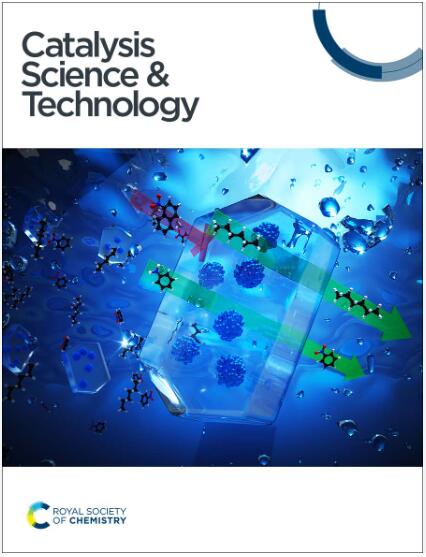Efficient CO2 reduction to methane on Ru2-based adjacent vacant graphene catalysts: insights into bimetallic synergies, thermodynamics, and kinetics†
IF 4.4
3区 化学
Q2 CHEMISTRY, PHYSICAL
引用次数: 0
Abstract
Electrochemical conversion of CO2 into value-added chemicals offers a clean pathway to utilize greenhouse gases along with the production of useful products. In this study, we aim to unravel a comprehensive reaction mechanism for the CO2 reduction reaction (CO2RR) into various C1-based products such as CO, HCOOH, CH2O, CH3OH, and CH4 using density functional theory (DFT). We analyse all possible reaction pathways and compute their thermodynamics on a novel two-dimensional catalyst system – two monovacant (adjacent-vacant) graphene sheet modified with two Ru atoms, referred to as 2MV-Ru2. Our reaction mechanism investigation identified the potential-determining step (PDS) as CO* → CHO*, which demands a limiting potential of −0.88 V vs. SHE (standard hydrogen electrode) for the production of methane. We also examined the PDS on a series of bimetallic electrodes, generally referred to as 2MV-RuM (M = Ag, Au, Cu, Ir, Os, Pd, Pt, and Rh). We found the 2MV-RuPd electrode as the most effective catalyst for methane production as it lowered the limiting potential of PDS to only −0.13 V vs. SHE, which is a remarkable improvement over both 2MV-Ru2 and conventional metallic electrodes. To supplement the thermodynamics, we also integrated kinetic analyses for the PDS to provide a more inclusive understanding of the reaction, which demonstrated the excellent capability of 2MV-RuPd electrode compared to 2MV-Ru2. Finally, we examined the stability of all bimetallic electrodes to ensure their practical applicability, and obtained favourable formation free energies, which advocate that these electrodes are not only theoretically feasible but also experimentally synthesizable. Overall, our study offers a rigorous analysis of the CO2RR on Ru-based adjacent-vacant (bimetallic) graphene catalysts. Superior thermodynamics and kinetics were demonstrated by the 2MV-RuPd electrode, thereby establishing it as a highly promising candidate for methane production. This work advances the understanding of CO2RR mechanisms along with providing a robust foundation for developing next-generation catalysts for sustainable chemical synthesis.

有效的二氧化碳还原为甲烷的钌基相邻空石墨烯催化剂:洞察双金属协同作用,热力学和动力学†
二氧化碳的电化学转化为增值化学品提供了一个清洁的途径来利用温室气体以及生产有用的产品。在本研究中,我们旨在利用密度泛函理论(DFT)揭示CO2还原反应(CO2RR)生成CO、HCOOH、CH2O、CH3OH和CH4等多种c1基产物的综合反应机理。我们分析了所有可能的反应途径,并在一个新的二维催化剂体系上计算了它们的热力学——两个单空(邻接空)石墨烯片被两个Ru原子修饰,称为2MV-Ru2。我们的反应机理研究确定了产甲烷的电位决定步骤(PDS)为CO*→CHO*,相对于SHE(标准氢电极)的极限电位为- 0.88 V。我们还研究了一系列双金属电极上的PDS,通常称为2MV-RuM (M = Ag, Au, Cu, Ir, Os, Pd, Pt和Rh)。我们发现2MV-RuPd电极是最有效的甲烷生成催化剂,因为它将PDS的极限电位降低到- 0.13 V,与2MV-Ru2和传统金属电极相比,这是一个显着的改进。为了补充热力学,我们还对PDS进行了动力学分析,以提供更全面的反应理解,这证明了2MV-RuPd电极与2MV-Ru2相比具有优异的性能。最后,我们测试了所有双金属电极的稳定性,以确保它们的实际适用性,并获得了良好的形成自由能,这表明这些电极不仅在理论上可行,而且在实验上是可合成的。总的来说,我们的研究对钌基邻接空(双金属)石墨烯催化剂上的CO2RR进行了严格的分析。2MV-RuPd电极具有优异的热力学和动力学性能,因此将其确定为极有前途的甲烷生产候选材料。这项工作促进了对CO2RR机制的理解,并为开发下一代可持续化学合成催化剂提供了坚实的基础。
本文章由计算机程序翻译,如有差异,请以英文原文为准。
求助全文
约1分钟内获得全文
求助全文
来源期刊

Catalysis Science & Technology
CHEMISTRY, PHYSICAL-
CiteScore
8.70
自引率
6.00%
发文量
587
审稿时长
1.5 months
期刊介绍:
A multidisciplinary journal focusing on cutting edge research across all fundamental science and technological aspects of catalysis.
Editor-in-chief: Bert Weckhuysen
Impact factor: 5.0
Time to first decision (peer reviewed only): 31 days
 求助内容:
求助内容: 应助结果提醒方式:
应助结果提醒方式:


